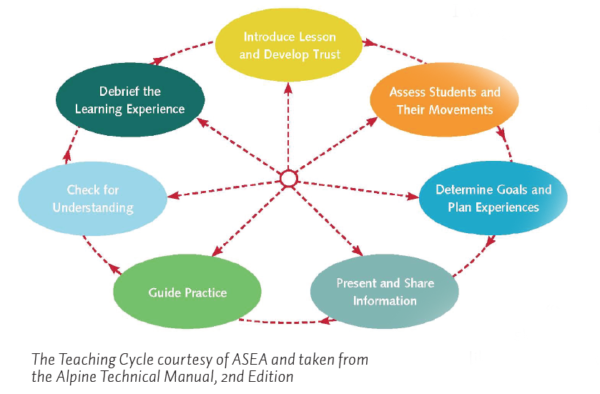Text and photos by Linda Cowan
 The state of education in our nation is a hot topic. As a result, the amount of research and study on the practices that lead to student learning are reaching unprecedented levels. The Center for Educational Leadership works in partnerships with school districts across the nation employing current research from University of Washington’s College of Education to maximize learning for all students. Core elements of high quality instruction are a primary focus of their work. There are several dimensions, but two of the key elements for effective instruction are purpose and teaching point.
The state of education in our nation is a hot topic. As a result, the amount of research and study on the practices that lead to student learning are reaching unprecedented levels. The Center for Educational Leadership works in partnerships with school districts across the nation employing current research from University of Washington’s College of Education to maximize learning for all students. Core elements of high quality instruction are a primary focus of their work. There are several dimensions, but two of the key elements for effective instruction are purpose and teaching point.
The purpose of this snowsports tip is to share the importance of having a clear purpose and teaching point every time we step in front of a group of students (or athletes if you’re a coach.)
Purpose is defined as being the “why or because”of our teaching, and the teaching point is the ‘what or how’ we achieve that purpose. Let me give an example of how I would start my teaching segment with a clear teaching point and purpose once my students have warmed up.
Follow me through this familiar scenario: After watching my students skate to the lift line, for our first run together, I can’t help but notice their hips continuously falling behind their feet. Now, I begin thinking through what I want to teach
and why.
“Class, everyone gather around, we have some important learning to do today! Effective skiers have continuous shin cuff contact because it allows them to balance on a moving surface.”
My teaching point (TP) in this teaching segment is to have continuous shin cuff contact, and the purpose for this movement is to stay balanced on a moving surface. By having a clear purpose for my teaching, now, every decision I make during this teaching cycle is intentional and meaningful and centered around this purpose.
“OK group, I am going to model for you what shin cuff contact looks like. What do you notice? Where are my hips? Where are my shoulders?”
I like to have my students quickly turn and talk with a neighbor so everyone is engaged in what I want them to see and eventually do. Cognitive engagement moves students towards physical success, and when I’ve heard several comments that show me understanding, I continue teaching. This is also checking for understanding, but holds higher accountability than “Does everyone understand?” which is a question most students are reluctant to respond with a “no.”
“Now I want to model for you what skiing backwards slowly in a wedge looks like and feels like on my shins. Remember shin cuff contact helps me to balance on a moving surface (TP). Once I can feel my shins against the front of my boots, I’m going to turn around and try to produce the same sensation on my shins while moving forward.”
 While moving through the teaching cycle, we know that students need to understand the teaching point for themselves, so I continue to weave in my teaching point verbally throughout my lesson as I model and share feedback with each student. The reason? If my supervisor slides up to my class, he or she should be able to ask any child (or adult) in my lesson, “What are you learning right now?” And my students need to be able to answer, “We are working on constant shin cuff contact because it helps us balance.” If my students are not able to articulate what we are doing and why, is my teaching truly effective? If I don’t hold my students accountable for understanding, how can they apply this learning to another environment on their own?
While moving through the teaching cycle, we know that students need to understand the teaching point for themselves, so I continue to weave in my teaching point verbally throughout my lesson as I model and share feedback with each student. The reason? If my supervisor slides up to my class, he or she should be able to ask any child (or adult) in my lesson, “What are you learning right now?” And my students need to be able to answer, “We are working on constant shin cuff contact because it helps us balance.” If my students are not able to articulate what we are doing and why, is my teaching truly effective? If I don’t hold my students accountable for understanding, how can they apply this learning to another environment on their own?
Providing effective instruction has many benefits for both students and instructors. For instructors, always having a clear teaching point and purpose, keeps our lessons meaningful and focused. For our students, this helps them to clearly see and understand what we are doing, and why and supports their owning the information for themselves, which should always be our end goal as teachers.
 Linda Cowan is a member of the PSIA-NW Technical Team, is an Alpine Examiner, coaches for Stevens Pass Alpine Club at Stevens Pass and is a 5th grade teacher at Woodmoor Elementary School, in Bothell, WA. Email: lindacowan1@mac.com
Linda Cowan is a member of the PSIA-NW Technical Team, is an Alpine Examiner, coaches for Stevens Pass Alpine Club at Stevens Pass and is a 5th grade teacher at Woodmoor Elementary School, in Bothell, WA. Email: lindacowan1@mac.com

One thought on “Teaching with a Purpose”
Great article. As a long-time middle school teacher, I’d just suggest that there are non-verbal ways for students to demonstrate understanding–and sometimes these ways are superior. A student may be able to parrot instruction without really having learned, and may be able to do and demonstrate what they can’t yet discuss. We don’t want to confuse public speaking skills with understanding and accomplishment of a task. A requirement to say back what you you’ve learned isn’t even a reliable indicator of listening behavior. But it’s great to provide kids with guided practice in putting what they understand into words.